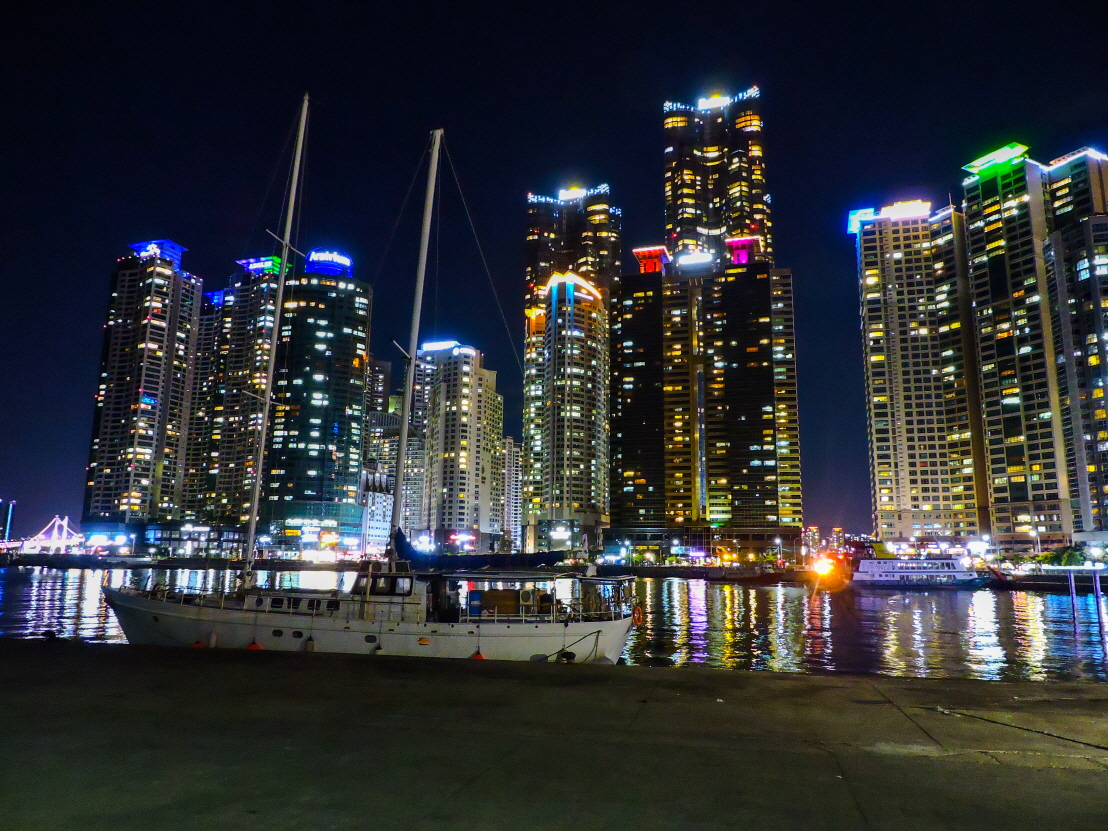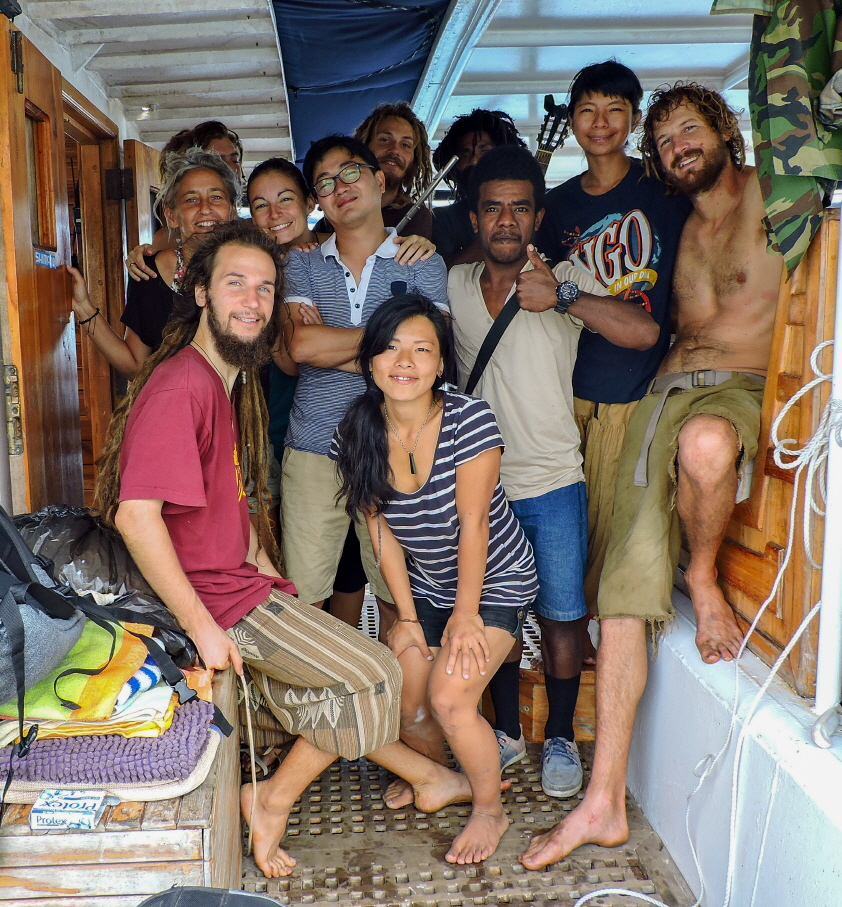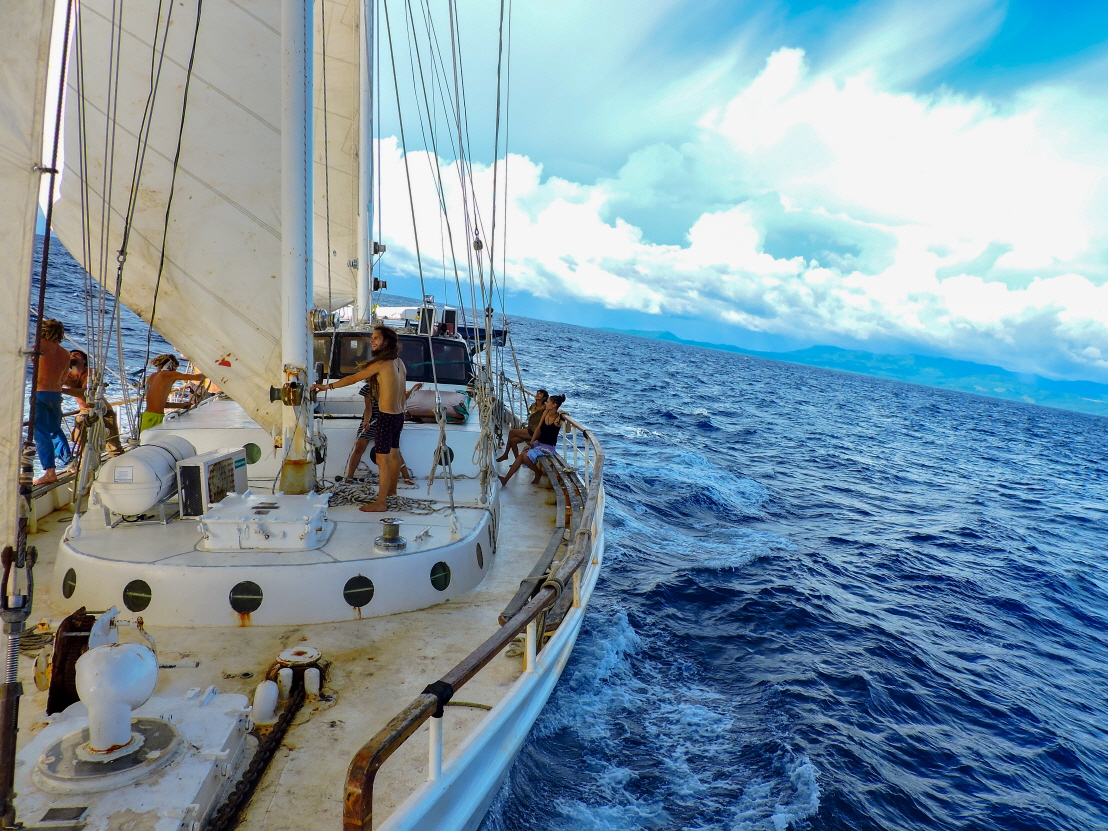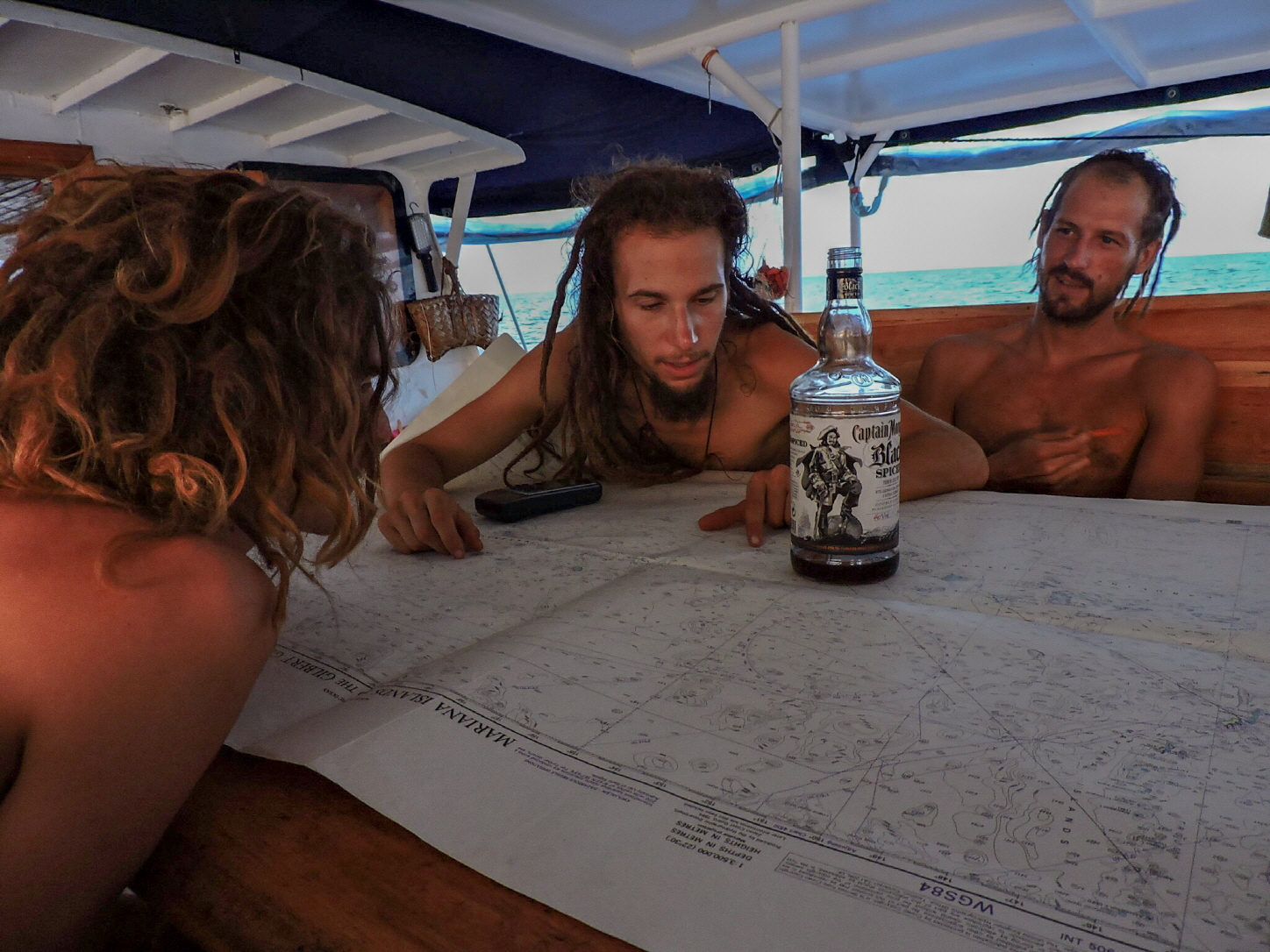Water Gypsy in Busan
물 위의 집시들

Sailing Boat Alabama at Her New home Dongbaek at night
새로운 집 동백에 정박한 밤에 촬영한 앨라배마호
If, like many Haeundae residents, you are in the habit of taking a walk on Dongbaek Island, you may have noticed a large, white sailing vessel tied up by Bay 101. Her name is Alabama, and she is the second largest sailing yacht in South Korea. She arrived in Busan in the last days of 2017, after a 6 month voyage from Fiji in the South Pacific. Her Korean owner, known fondly as Windy, bought Alabama after seeing an advertisement online. After a long period of preparation, she was getting ready to make the 4000 nautical mile voyage to her new home in Busan; all she needed was a crew...
A year earlier, I was in Mokpo making repairs to my 38ft steel yacht, Four Winds. We were 5 crew members at that time, myself, Tom, a 32 year old Englishman and owner of the Four Winds, my Taiwanese girlfriend Afra, who joined the crew in 2016, Marcello, from Italy and his Japanese girlfriend Asuka, and Sebastien, a Parisian who joined in Papua New Guinea. Mokpo locals often stopped by to talk or brought gifts. They asked questions and tried out their English on us. We were used to this after a long time travelling. It is true that all around the world, people are curious and people are good! One of those passersby became a regular visitor, and after a while, he told us of his plan to deliver a boat from Fiji to Busan, for a friend of his named Windy. Of course he needed a crew, and after so much work on Four Winds, and with the cold Korean winter settling in, we jumped at the chance! We met up with Windy and thus began our friendship that I expect to last a lifetime. He is our Korean father and we have much to thank him for. When our Korean friend who led us to Windy decided not to go ahead with the delivery, it became our next adventure.
많은 해운대 거주자들이 그렇듯, 동백섬 산책을 즐기는 사람이라면 베이 101에 묶인 하얗고 커다란 범선을 본 적 이 있을 것이다. 그 배의 이름은 앨라배마로, 한국에서 두 번째로 큰 세일링 요트이다. 앨라배마는 2017년 말, 남태 평양 피지섬에서부터 6개월 간의 항해 끝에 부산에 도착했다. 윈디라는 애칭으로 불리는 앨라배마의 한국인 소유주 는 온라인에서 광고를 본 뒤 앨라배마를 구매했고, 오랜 준비 끝에 새로운 집이 될 부산까지 4000 해리를 항해했다. 앨라배마에게 필요한 단 한 가지는 크루였다.
작년에 나는 목포에서 38피트 길이 강철로 만든 요트인 포윈드(Four Winds)를 수리하고 있었다. 32세의 영국인이자 포윈드의 주인인 나, 나의 타이완인 여자친구이자 2016년 합류한 아프라(Afra), 이탈리아인 마르셀로(Marcello)와 그의 일본인 여자친구 아스카(Asuka), 파푸아뉴기니에서 합류한 파리지앵 세바스티앙(Sebastien) 등 우리 다섯 명이 포 윈드의 크루였다. 목포 사람들은 가끔 지나가다 말을 걸거나 선물을 가져다 주셨다. 우리에게 질문을 던지거나 영어 대화를 시도하기도 했다. 오랜 여행을 한 우리는 이미 이런 일에 익숙해져 있었다. 전 세계 어디에서나 사람들은 호기심이 많고 친절했다! 지나다니던 사람들 중 한 사람은 어느새 우리와 친해져 윈디가 피지에서 부산까지 세일링 요트를 가져오고 싶다는 계획을 우리에게 말해 주었다. 물론 그는 크루가 필요했다. 그랬기에 포 윈드 수리 작업이 어느 정도 끝나고 한국의 추운 겨울에 적응했을 무렵 우리가 바로 그 기회를 붙잡았던 것이다! 윈디와 만난 우리는 이 인연이 영원히 이어지길 바라며 우정을 쌓아 나갔다.
그는 이제 우리에게 고마운 ‘한국 아버지’가 되었다. 우리에게 윈디를 소개해 준 한국인 친구가 항해에 참여하지 않기로 결정했을 때, 우리의 모험이 시작되었다.
We set off for Fiji in July of 2017. When I arrived and saw Alabama in Vuda Marina in Fiji, I was amazed at her size and weight. She is 25 meters long and weighs over 90 tones! That is the equivalent of 45 automobiles. I had never navigated anything that large before, and as captain, I had a steep learning curve! Work was hard. The boat hadn’t moved in 2 years and there were many things to do before we could head out to sea. The anchor was bent, the sails torn and the engine room was a mess! On top of the repairs, we had to learn the systems. To be a sailor, you must learn to be an electrician, plumber and engineer as well as being able to pull up the anchor, handle the lines, navigate and sail!
2017년 7월, 우리는 피지로 떠났다. 피지 부다 마리나(Vuda Marina)에 도착해 앨라배마를 처음 봤을 때 나는 그 어마어마한 크기와 무게에 놀라고 말았다. 앨라배마는오토바이 45대에 준하는 자그마치 길이 25미터, 무게 90 톤에 육박한다! 그 때까지 나는 선장으로서 그만한 크기의 배를 타 본 적이 없었다. 내 학습 곡선이 가팔라졌다! 힘든 과정이었다. 앨라배마는 2년 째 운행되지 않은 상태였기에 바다로 나가기 전 준비해야 할 것이 많았다. 구부러진 닻, 찢어진 돛, 지저분한 엔진실까지! 그 중에서도 가장 큰 문제는 시스템을 익혀야 한다는 사실이었다. 항해사가 된다는 것은 전기기사, 배관공, 엔지니어가 되어야 했다. 닻을 끌어올리는 법, 선을 관리하는 법, 항해하는 방법도 알아야 했다!

Crews on the Alabama
앨라배마호의 크루들
Our crew at that time consisted of myself, Afra, Sebastian, our Korean friend, Mr Choi, who was our spokesperson when dealing with Windy and a young Fijian by the name of Sesoni who had been working on Alabama since Windy bought her. Two of our crew members were waiting for us in Vanuatu, so we were 5, but only 2 were competent sailors. We needed help, and help arrived, in the form of a lovely Bulgarian couple, walking the docks in search of a voyage! I met Tim in the afternoon, and the next day he showed up for work, an excellent way to impress a captain! He was there again the next day, and the next, and so they joined the crew and we were 5 again! We convinced 2 more, my brother, James and his girlfriend Kerry, on holiday from their jobs on fishing boats in New Zealand, and having now a crew of 9, I was feeling a lot better about taking Alabama to sea. Before we left though, we rounded that number up to an even 10 with the addition of a French lady, Celine, who had been in Fiji to sail with a captain she met online, she decided instead to jump ship and sail with our motley crew.
So when Alabama finally left harbour it was a momentous occasion. We had around 500 miles to our next destination, Vanuatu. But first, we had to test our repairs under working conditions, so we headed to a nearby bay to anchor for the night, but as we tried to drop the anchor, the winch failed, so we hovered in the bay while the electricians figured things out! Once that was done, we set our sights a little further, to some of the outlying Fijian Islands to the East, where, a couple of years earlier, we had swum with Manta rays and sipped coconuts on idyllic beaches. This time it was the steering systems turn to fail! Can you steer a 90 tonne boat by hand?! Yes. We put on the emergency tiller, a 2.5 meter wooden arm that fits directly onto the rudder, and nursed her into a small bay, in the dead of night, and dropped anchor safely. Phew! We repaired the steering system, but often used the tiller later because of the silence, (the steering system is hydraulic and must be powered by a generator) and the good feeling of helming by hand.
당시 우리 크루는 나, 아프라, 세바스티앙, 윈디와의 거래에서 대변인이 되어준 한국인 친구 최, 윈디가 앨라배마를 구매한 시점부터 세소니(Sesoni)라는 이름으로 일해 온 젊은 피지 사람이 다였다. 두 명은 바누아투에서 기다리고 있었고 총 5명이지만 경험이 많은 항해사는 단 2명이었다. 우리는 도움이 필요했고, 부두를 거닐며 모험을 찾고 있던 사랑스러운 불가리아 커플이 바로 그 도움의 손길을 내밀었다. 나는 그 날 오후 팀(Tim)을 만났고, 그 다음 날 나타난 그는 선장을 감동시킬 만큼 훌륭했다. 다음 날도, 그 다음날도 계속 우리를 찾아온 그는 마침내 우리 크루가 되었고, 크루는 다시 5명이 되었다. 휴가를 맞이해 뉴질랜드에서 낚싯배를 타고 있던 내 동생 제임스와 그의 여자친구 케리까지 설득해 총 9명의 크루가 모였다. 앨라배마호와 바다로 나가는 일이 보다 쉬워진 것 같았다. 그래도 우리는 출항하기 전, 온라인에서 만난 선장과 항해를 즐기기 위해 피지에 와 있던 프랑스 여성 셀린느(Celine)까지 포함해 총 10명이 되었다. 셀린느는 원래 항해하던 배 대신 우리 보트의 크루가 되기로 했다.
앨라배마호의 출항은 중대한 사건이었다. 다음 목적지인 바누아투까지는 약 500 마일 정도 거리였다. 수리를 마친 앨라배마호가 실제 상황에서도 잘 작동하는지 알아보아야 했던 우리는 가까운 해안에 닻을 내리고 하룻밤 정박하기로 했다. 하지만 막상 닻을 내리려고 했을 때 윈치가 제대 로 작동하지 않는 탓에 전기기사가 문제를 해결할 때까지 해안을 빙빙 돌아야만 했다! 그 일이 해결된 후, 우리는 눈을 좀 더 먼 곳으로 돌려 피지 섬 바깥 동쪽으로 향하기로 했다. 몇 년 전 우리가 큰 가오리와 수영을 하고 평화로운 해안가에서 코코넛을 마시던 곳이었다. 하지만 이번에는 조타기가 고장 나고 말았다! 90톤에 육박하는 보트를 수동으로 조종하는 게 가능할까? 답은 ‘그렇다’이다. 우리는 한 밤 중에 고무 쪽으로 바로 기울어지는 2.5미터짜리 나무 손잡이를 이용해 배를 작은 만에 댄 뒤 안전하게 닻을 내렸다. 휴! 조타기는 수리했지만 나중에는 소리 때문에 수동 손잡이를 가끔 이용하기도 했다(조타기는 수력으로 작동하며 발전기가 필요했다). 손잡이를 직접 조종하는 느낌을 좋아했던 것도 또 다른 이유였다.

Sailing
항해
Now we were set for an international crossing, to Port Villa, Efate Island, Vanuatu. The wind was favourable and we made good time for the first 2 days, running the motor and sailing at the same time gave us a good speed, but the waves were hitting us on the beam (the side of the boat) and as a result we were rolling pretty hard! On the 3rd day, I walked to the stern to check the fishing line that we always leave out when the boat is moving fast enough to attract fish. There were no fish in sight, but I was not a little troubled to see the propellor, on its long shaft, hanging a meter behind the boat! What to do?! There is a hole where the propeller shaft enters the boat and connects to the gearbox and engine, if the shaft had come out, then there must be water coming in through the hole where it was supposed to be! I ran down to the engine room to find nothing unusual, the motor was running and the shaft turning as if nothing was the matter, luckily it had broken just outside the boat, and the stub remained in place to fill the hole. Now what to do?Well, a propellor and shaft are important and expensive parts of a boat. We had to secure it, or bring it on board, but gosh is that thing heavy! Using some lines and weights, and eventually a fishing net, we managed to snag the propellor and secure it to the boat. It was still hanging on to its last bracket and no amount of wiggling from above could free it.
Luckily, like a loose tooth, it made its own way out, and we had it hanging by a line, now how to get it on board? We tried by hand, but despite our efforts, it was just too heavy to get over the rail and into the boat, so we took a halyard (a line from the top of the mast that we use to hoist sails) and started to winch her up... Up she came, and the guys on deck held her tight, but we had to go higher and higher to get the bottom end over the rail, and at the critical moment, the boat began to roll. The guys lost their grip and out swung the shaft and prop. What goes up must come down, and as the boat rolled back, the whole thing came hurtling towards the boat! BANG! She hit the rail, sending crew running for cover, and breaking the wood and steel. Out she goes again... this time she swung a little forward and crossed the deck, banging into the rigging used to support the masts, this was our chance and we leapt on it before it had chance to go for another swing! Woo Hoo! We lashed her down along the length of the boom and went to have a cup of tea to calm our nerves!
이제 우리는 바누아투 에파테섬의 포트 빌라로 떠날 준비가 되었다. 순풍이 불었고, 첫 이틀 간은 모든 것이 순조로웠다. 모터를 돌려 성공적인 출항을 했다. 하지만 파도가 배의 옆면을 때리는 바람에 우리는 배 안에서 굴러다니고 말았다! 셋째 날, 나는 선미로 나가 물고기가 걸려들 만큼 배가 속력을 낼 때를 위해 걸어둔 낚싯줄을 확인했다. 물고기는 없었지만 선미에서 1미터 정도 뒤에 매달린 긴 샤프트 끝에 있는 프로펠러를 보았다. 프로펠러 샤프트가 기어 박스와 엔진으로 연결되는 곳에는 구멍이 있었는데, 샤프트가 빠지면 그 구멍으로 물이 차오를 것이 분명했다! 나는 엔진실로 달려가 문제가 없는지 확인했다. 아무런 문제도 없다는 듯 모터도 샤프트도 잘 움직이고 있었다. 운 좋게도 배 바깥만 고장이 난 모양이었다. 샤프트 끝 부분도 제 자리에서 구멍을 잘 막고 있었다. 머리 속이 하얘졌다. 프로펠러와 샤프트는 배의 중요한 부분이자 비싼 부품이기 때문이다. 우린 그 부품을 지켜야 했다. 아니면 배에 가져오기라도 해야 했다. 하지만 프로펠러와 샤프트는 터무니없이 무겁기 때문에 줄과 추, 결국에는 어망까지 동원하고 나서야 그 문제의 프로펠러를 확보할 수 있었다. 그렇지만 프로펠러는 여전히 받침에 붙어 있었고, 어떻게 해도 그걸 꺼내기란 힘들 것 같았다.
하지만 운 좋게도 프로펠러는 마치 흔들리는 이처럼 쉽게 빠졌다. 하지만 이제 줄에 묶인 프로펠러를 어떻게 배 위로 끌어올린단 말인가? 손으로 직접 당겨보았지만 노력은 허사로 돌아갔다. 프로펠러가 너무 무거워서 레일을 넘어 배 안으로 끌어올릴 수가 없었다. 그래서 우리는 핼야드(돛을 끌어올리기 위해 돛대 끝에 달린 줄)를 이용하기로 했다. 프로펠러가 올라오자 남자들이 모여 단단히 붙잡았다. 하지만 레일을 넘기려면 프로펠러를 훨씬 더 높이 들어올려야 했고, 결정적인 순간 배가 구르기 시작했다. 우리는 프로펠러를 놓치고 마구 흔들렸다. 한 번 올라간 것은 반드시 땅으로 떨어지는 법. 배가 다시 휘청하자 프로펠러가 배 위로 떨어졌다. 쿵! 프로펠러는 레일에 부딪혔다. 크루들은 숨을 곳을 찾아 달려갔고, 나무와 철이 부러졌다. 프로펠러가 다시 한 번 쿵 소리를 냈다. 이번에는 갑판을 가로질러 약간 앞쪽에 떨어지며 돛대를 지지하는 로프를 쳤다. 우리는 이 기회를 놓치지 않고 프로펠러가 또 한 번 흔들리기 전에 그 위로 뛰어올랐다. 예! 우리는 하활에 프로펠러를 묶은 뒤 차를 마시며 마음을 진정시켰다.

Stirring with a tiller
수동 손잡이로 조종하는 모습
Well, we journeyed on under sail, and our other engine, luckily, Alabama has 2. After a week at sea, we arrived in Port Villa! At that time of year, late July, it is typhoon season in the Northern Hemisphere, so our plan was to spend some time in Vanuatu waiting for a safe time to go North, stop in Micronesia to break the long voyage, and then up to Busan! So we spent a very nice time exploring those wonderful Islands of Vanuatu, the people, the beaches, the delicious vegetarian foods, volcanos and coral reefs. What more could we wish for? My brother and his girlfriend went back to work, Celine flew home to Fance, Sesoni left for Fiji and Mr. Choi returned to Mokpo, but new crew arrived, a Frenchman who was sailing there with a friend of ours and an Argentinian, a sailor friend from the past. We took 2 Korean families for a 2 week cruise. They were living in Port Villa with 5 kids. It was nice for them to see some of the smaller Islands. Eventually the time came to leave, and we set our sights North, to Kosrae Island, Micronesia, a tiny dot on an endless blue.
We covered the 1500 miles from Sola, Vanuatu to Kosrae in 10 days, an Alabama record! There we saw the effects of "development" on an indigenous people quite clearly. Vanuatu has been largely left undeveloped until now (China is changing that) and as a result, the people are healthy and happy, the bush and ocean are free from plastic pollution, and the local cultures are alive and well. Here in Micronesia, the people have largely left the forest and garden for the developing towns and jobs. They seem to be not as healthy, eating lots of sugar and processed foods, and there was more effort to charge money when visitors want to see a waterfall or other natural feature
In Micronesia, we saw the evidence of an ancient civilisation that had built massive structures from the basalt stone that occurs there as a result of volcanic activity. These stones are enormous and what remains of the structures is impressive, especially as they were built without the use of machinery. After Kosrae, we visited Pohnpei, carrying with us 2 more crew members, both American, who came only for the short voyage to Pohnpei, but one, Nick, continued with us all the way to Busan! Our last stop in Micronesia was the idyllic Ahd Atoll, a ring of coconut trees, surrounding a peaceful lagoon, populated with many kinds of beautiful fish, and an excellent chance for us to swim with the sharks.
우리는 여정을 계속했다. 다행히 앨라배마호에는 엔진이 두 개였기에 다른 하나가 제대로 작동해 주었다. 바다 위에서 1주일을 보낸 후, 우리는 포트 빌라에 도착했다! 그 해 7월 말, 북반구는 태풍 시즌이었다. 우리는 안전하게 북반구에 갈 수 있을 때까지 바누아투에서 시간을 보낼 예정이었다. 미크로네시아에서 휴식을 취한 뒤 부산으로 올라가는게 우리의 계획이었다! 우리는 그 동안 바누아투의 경관, 사람들, 해변, 맛있는 채식 음식, 화산과 산호초를 구경하며 멋진 시간을 보냈다. 더 이상 바랄 것이 없었다. 내 동생과 그의 여자친구는 업무로 복귀했고, 셀린느는 고향인 프랑스로, 세소니는 피지로, 한국인 최는 목포로 돌아갔다. 하지만 우리 친구 중 한 명, 항해하고 있던 프랑스인 한 명, 예전에 알고 지내던 항해사 친구 아르헨티나인 한 명이 새로운 크루로 들어왔다. 한국인 가족 두 팀도 2주 간의 크루즈 여행에 참여했다. 5명의 아이들과 함께 포트 빌라에 살고 있는 가족들이었다. 그들은 작은 섬들을 둘러보며 행복한 시간을 보냈다. 그 후 마침내 떠나야 할 시간이 왔다. 우리는 북쪽으로 향했다. 목적지는 미크로네시아의 코스라에섬. 망망대해 위 작은 점 같은 섬이었다.
바누아투 솔라에서 코스라에섬까지 1500 마일. 앨라배마호는 1500마일을 10일만에 항해한 기록을 세웠다. 그 곳에서 우리는 “개발”이 토착민에게 미치는 영향을 분명하게 목격했다. 바누아투는 아직까지도 거의 개발되지 않은 곳이고(중국이 현재 그곳에 변화를 가져오고 있다) 덕분에 그곳 사람들을 무척 건강하고 행복했으며, 바다와 초목에서는 플라스틱 쓰레기라고는 찾아볼 수 없었고, 그들만의 문화도 생생히 살아있었다. 이 곳 미크로네시아에서는 많은 사람들이 숲을 떠나 일자리를 찾아 발전된 도시로 가고 있었다. 사람들은 많은 양의 설탕과 가공 식품을 소비하며 그다지 건강하지 않은 식생활을 하고 있었고, 폭포나 다른 자연 경관을 구경하려는 관광객들에게 바가지 요금을 씌우려 했다.
미크로네시아에서는 화산 작용으로 만들어진 현무암으로 고대 문명이 이룩한 거대한 건축물의 흔적을 보았다. 현무암은 말 그대로 거대했고, 남아있는 흔적들도 인상적이었다. 더더욱 놀라운 것은 이 건축물들이 기계의 힘을 전혀 빌리지 않고 만들어졌다는 것이다. 코스라에섬을 떠난 우리는 2명의 새로운 미국인 크루와 함께 폰페이섬으로 갔다. 두 사람은 순전히 폰페이섬까지 짧은 항해만 할 예정이었으나 그 중 한 명인 닉은 우리와 부산까지 함께했다! 미크로네시아에서는 평화로운 산호섬에 정박했다. 평화로운 석호 주변을 코코넛 나무가 둥글게 감싸고 있고, 아름다운 물고기가 헤엄을 치고, 우리는 상어와 함께 수영했다.

Crew plotting with chart
지도를 보며 논의하고 있다
Our next destination was Chichi Jima, part of the Ogasawara Islands South of Japan. Here we made many good friends and enjoyed Japanese food and parties before heading out again to Beppu, in Kyushu. By this time it was getting cold! No more naked swimming and coconut beaches, but how better to compensate than a dip in an onsen? Onsen is the Japanese word for a natural hot spring, and Beppu has hundreds! We soaked, and prepared for the final 2 legs of our journey. Leaving Beppu in the late evening, we timed our trip to coincide with the strong tidal currents that surge through the small channel that separates Kyushu and Honshu, the largest of the Japanese Islands. We got it right, and the following morning saw us screaming through the pass at 12.5 knots, more than double our usual cursing speed! We shot out like a bullet and made a nice stop in Tsushima before setting sights for "home" and Dongbaek Island. Alabama will rest here for a while and should be cruising locally soon.
That’s our story, in a nutshell, in reality it’s the tip of the iceberg... summer will see us sailing again, perhaps you would like to join us, who knows what can happen when you're just passing by?
우리의 다음 목적지는 일본 남부 오가사와라 제도의 일 부인 지치지마섬이었다. 큐슈 벳푸로 떠나기 전, 우리는 이 곳에서 좋은 친구들과 맛있는 음식과 파티를 즐겼다. 이즈음 날씨는 점점 쌀쌀해지고 있었다! 더 이상 벌거벗고 수영을 하거나 해변에서 코코넛을 즐길 수는 없었지만, 따뜻한 온천은 충분한 보상이 되어 주었다. 온센은 일본어로 온천을 의미하는데, 벳푸에만도 수백 개의 온천이 있었다! 우리는 온천을 즐기며 여행 막바지를 위해 힘을 보충했다. 우리가 벳푸를 떠난 것은 늦은 저녁이었다. 큐슈와 일본에서 가장 큰 섬인 혼슈를 나누는 물길이 강해지는 시간에 맞춘 것이다. 시간을 잘 맞춘 덕에 다음 날 아침에는 평소 항해 속도의 두 배 이상인 12.5 노트로 달리며 환호할 수 있었다. 우리는 총알처럼 날아 새로운 “집”인 동백섬에 다다르기 전 마지막으로 대마도에 정박했다. 앨라배마호는 여기에서 조금 휴식을 취한 뒤 집에 닿을 것이었다.
이게 우리의 간략한 항해 이야기다. 실제 이야기에 비하면 빙산의 일각에 불과하지만 말이다. 여름이면 우린 다시 바다로 나갈 것이다. 이 글을 읽는 분들 중에는 우리와 함께하고 싶은 분도 계시리라. 스쳐 지나가던 인연이 어떻게 발전할지는 아무도 모르는 일이다!
Contributing Writer l Thomas Billingham (토마스 빌링햄)

